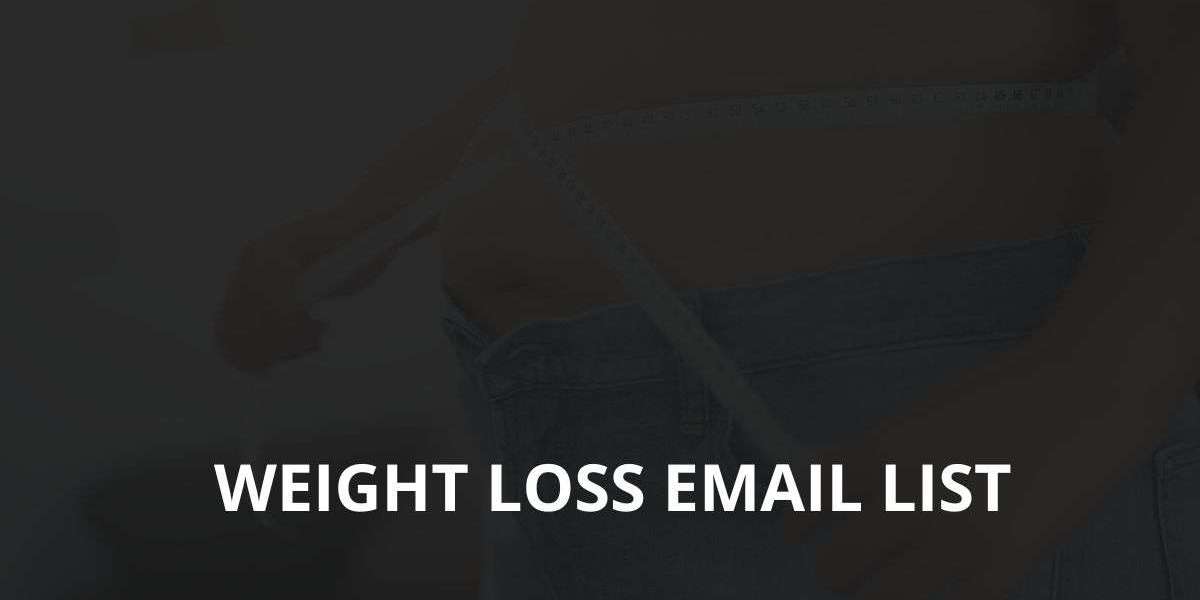The weight loss industry is a thriving sector, driven by growing consumer interest in health, fitness, and wellness. With millions of individuals seeking solutions for weight management, businesses in this space—whether offering supplements, fitness programs, or coaching services—need effective ways to connect with their target audience. A Weight Loss Email List is a powerful tool for reaching potential customers and building lasting relationships. This article explores the significance of such a list, its benefits, how to build and utilize it effectively, and best practices for maximizing its impact in business-to-consumer (B2C) and business-to-business (B2B) marketing.
What is a Weight Loss Email List?
A Weight Loss Email List is a curated database containing email addresses of individuals or businesses interested in weight loss products, services, or information. This could include fitness enthusiasts, dieters, health coaches, gym owners, nutritionists, or wellness influencers. The list is typically used for email marketing campaigns to promote products like supplements, meal plans, fitness equipment, or weight loss programs, or to share valuable content such as tips, recipes, or success stories.
The list can target both consumers seeking personal weight loss solutions and professionals in the health and fitness industry who influence purchasing decisions or offer related services.
Why a Weight Loss Email List is Essential
The weight loss market is highly competitive, with businesses vying for consumer attention in a crowded space. A targeted email list offers several key advantages:
Direct Access to Interested Audiences: An email list connects you with individuals or businesses already interested in weight loss, increasing the likelihood of engagement.
Cost-Effective Marketing: Email marketing is one of the most affordable ways to reach a large audience, offering a high return on investment compared to paid ads or traditional media.
Higher Conversion Rates: Since the list targets people with a specific interest in weight loss, your campaigns are more likely to resonate, leading to better open rates and conversions.
Personalized Engagement: Detailed data, such as demographics or fitness goals, allows for tailored campaigns that address individual needs, such as weight loss for busy professionals or post-pregnancy fitness.
Scalability: Whether targeting local fitness enthusiasts or a global audience, an email list can be scaled to meet your business goals.
How to Build a High-Quality Weight Loss Email List
Creating an effective email list requires strategic planning and ethical practices. Here’s how to build a high-quality Weight Loss Email List:
1. Define Your Target Audience
Identify the specific segment you want to reach. Are you targeting:
Consumers (e.g., women aged 25-45, fitness beginners, or post-pregnancy mothers)?
Professionals (e.g., gym owners, personal trainers, or dietitians)?
Specific niches (e.g., vegan weight loss, keto dieters, or seniors)? Understanding your audience’s needs and preferences will help you create a relevant list.
2. Collect Data Ethically
Avoid purchasing email lists from unverified sources, as they may contain outdated or non-consenting contacts, leading to low engagement and potential legal issues. Instead, use these methods:
Website Lead Magnets: Offer valuable content like free eBooks, meal plans, or workout guides on your website in exchange for email addresses.
Social Media Campaigns: Run contests or giveaways on platforms like Instagram or TikTok, encouraging users to sign up for your email list.
Partnerships: Collaborate with fitness influencers, gyms, or wellness blogs to collect opt-in emails from their audiences.
Events and Workshops: Gather contacts at fitness expos, webinars, or local health events by offering sign-up incentives.
3. Verify and Segment the List
Use email verification tools to ensure deliverability and accuracy. Segment the list based on criteria such as:
Demographics (e.g., age, gender, location)
Interests (e.g., weight loss supplements, fitness apps, or meal delivery services)
Behavior (e.g., frequent gym-goers, occasional dieters)
Professional roles (e.g., fitness trainers, wellness coaches) Segmentation enables more targeted and effective campaigns.
4. Comply with Data Privacy Regulations
Adhere to laws like the General Data Protection Regulation (GDPR) in Europe, the CAN-SPAM Act in the United States, or other regional regulations. Ensure recipients have opted in to receive your emails and provide an easy unsubscribe option.
Strategies for Using a Weight Loss Email List Effectively
A high-quality email list is only as effective as the strategies used to leverage it. Here’s how to maximize its potential:
1. Craft Engaging Email Content
Your emails should be compelling, relevant, and value-driven. Consider these tips:
Subject Line: Use attention-grabbing subject lines like “Lose 10 Pounds with This Simple Plan” or “Exclusive Offer for Fitness Professionals.”
Personalization: Address recipients by name and tailor content to their goals, such as weight loss for busy schedules or muscle-building diets.
Value Proposition: Highlight how your product or service solves a problem, such as convenient meal plans or affordable fitness tools.
Call to Action (CTA): Include clear CTAs, such as signing up for a free trial, joining a fitness challenge, or purchasing a product.
2. Use Email Automation Tools
Platforms like Mailchimp, ActiveCampaign, or ConvertKit can streamline your campaigns by:
Scheduling emails for optimal times.
Tracking metrics like open rates, click-throughs, and conversions.
Automating welcome sequences or follow-up emails for non-responders.
3. Test and Optimize Campaigns
Run A/B tests to compare subject lines, email designs, or CTAs to determine what resonates best. Use analytics to refine your approach and improve performance over time.
4. Focus on Building Trust
The weight loss industry often faces skepticism due to overhyped claims. Build trust by:
Sharing success stories or testimonials from real customers.
Providing evidence-based tips, such as science-backed nutrition advice.
Avoiding exaggerated promises and focusing on realistic, sustainable results.
Best Practices for Weight Loss Email Marketing
To ensure your campaigns succeed, follow these best practices:
Maintain List Hygiene: Regularly update your list to remove inactive or invalid emails, ensuring high deliverability.
Balance Frequency: Send emails at a reasonable frequency (e.g., weekly or biweekly) to avoid overwhelming recipients.
Provide Value: Share free resources like workout plans, recipes, or mindfulness tips to keep subscribers engaged.
Optimize for Mobile: Ensure emails are mobile-friendly, as many users access emails on their phones.
Track Performance: Monitor key performance indicators (KPIs) like open rates, click-through rates, and unsubscribe rates to gauge success.
Challenges and Solutions
Using a Weight Loss Email List comes with challenges. Here’s how to address them:
Challenge: Low engagement due to generic content.
Solution: Use segmentation and personalization to deliver relevant messages.Challenge: High unsubscribe rates.
Solution: Ensure opt-in consent and provide valuable, non-spammy content.Challenge: Emails landing in spam folders.
Solution: Use verified emails, avoid trigger words, and maintain a strong sender reputation.
The Future of Weight Loss Email Lists
The weight loss industry is evolving with trends like personalized nutrition, wearable fitness tech, and holistic wellness. Email lists will remain a vital tool for reaching this audience, but businesses must adapt to new developments:
AI-Powered Personalization: Use AI to analyze subscriber behavior and deliver tailored content, such as personalized meal plans.
Integration with CRM Systems: Sync email lists with CRM platforms like Salesforce or Zoho for better lead tracking.
Focus on Holistic Wellness: Highlight solutions that combine weight loss with mental health, stress management, or sustainable lifestyles.
Conclusion
A Weight Loss Email List is a game-changer for businesses aiming to connect with consumers and professionals in the health and fitness industry. By building a high-quality, segmented list and using it strategically, companies can drive engagement, foster trust, and grow their customer base. Ethical data collection, personalized content, and continuous optimization are key to success. As the weight loss market evolves, businesses that leverage email lists effectively will stand out, building meaningful connections in this dynamic industry.








